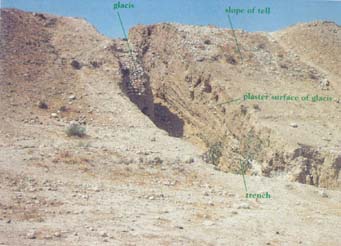Glossary: A Question of Defense
Glacis, Casemate Wall and Offset-Inset Wall

Glacis
The term “glacis” (gla-SEE), adopted from European military nomenclature, describes the massive earthen ramparts that surrounded virtually every important Canaanite city during the latter part of the Middle Bronze Age (c. 2000 to 1550 B.C.). This elaborate fortification system completely covered and reinforced the slopes of the mound on which the city was situated, hindering a direct enemy attack—by either assault troops or battering rams—against the main city wall on the summit.
Constructed of hard-packed layers of beaten earth, the glacis was often strengthened by a stone core or internal retaining walls, and was made even more formidable by a deep fosse, or dry moat, dug at its base. The steep slope of the glacis was usually covered with a layer of stone or a smooth plaster surface to prevent erosion and to make the enemy’s approach as difficult as possible. Although uniform in overall conception, each Canaanite city’s glacis was distinctive; each was suited to the city’s specific topographical situation and to the building materials at hand.
Already a library member? Log in here.
Institution user? Log in with your IP address.

